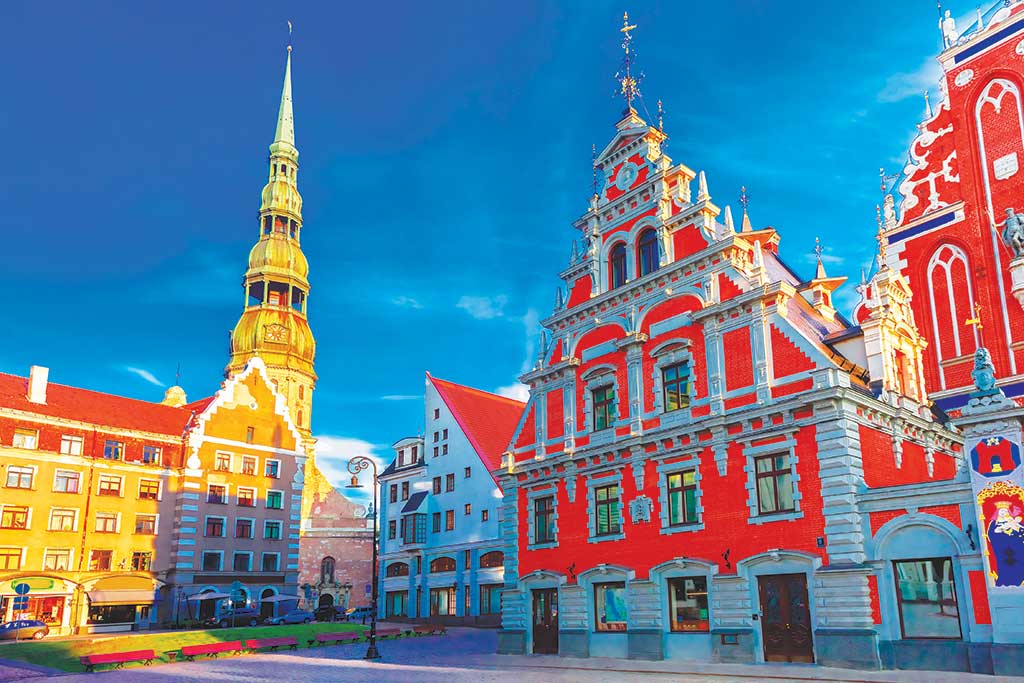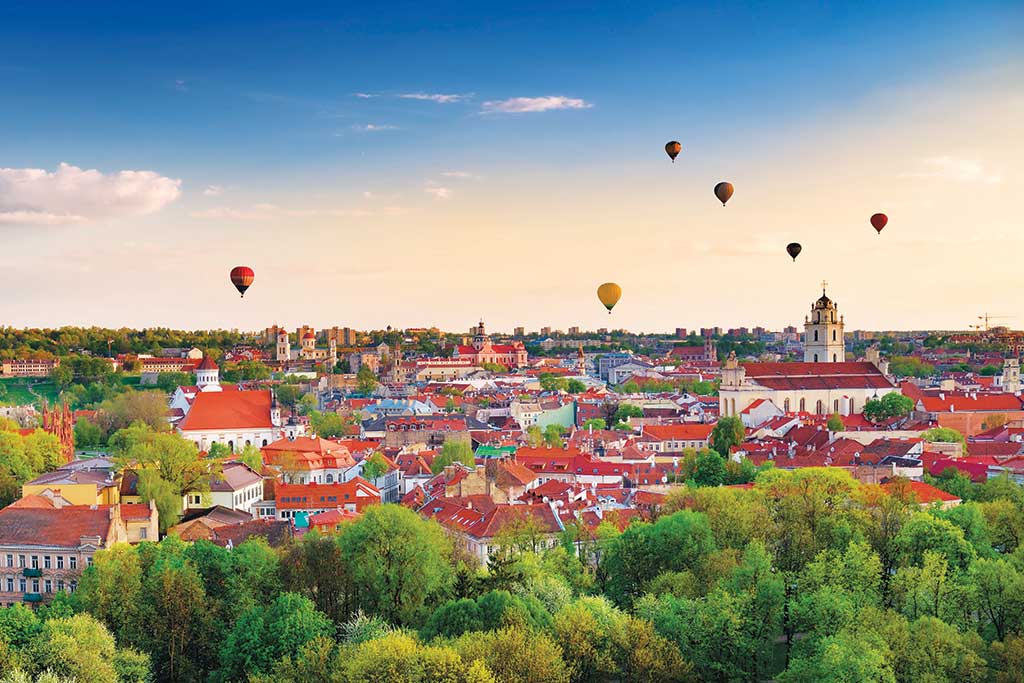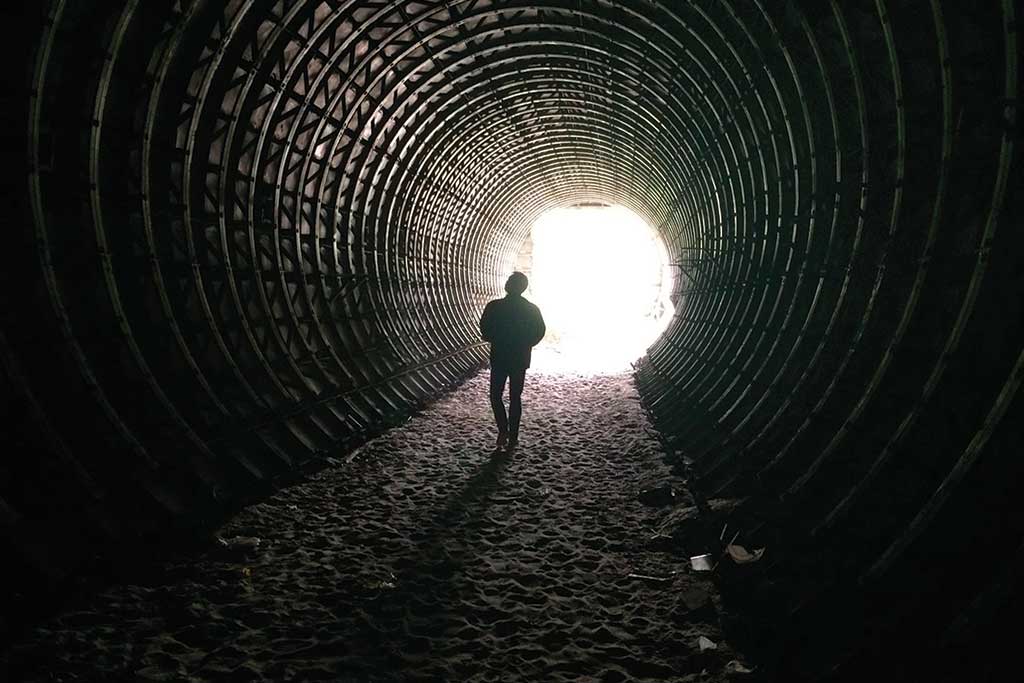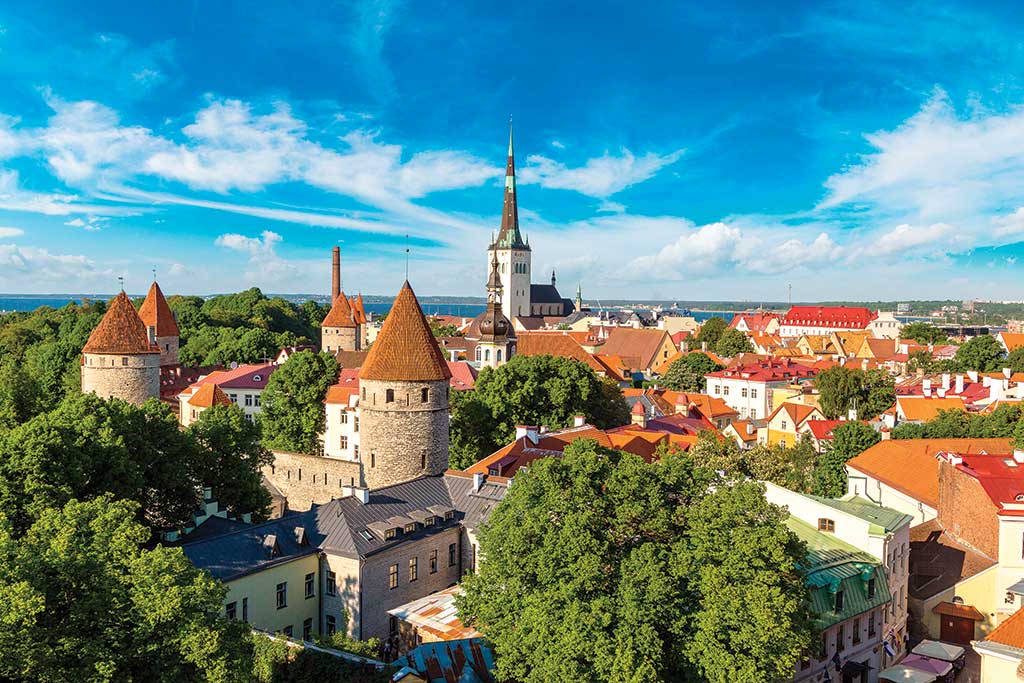During my next stop in Latvia, my focus was on Riga, the dynamic capital and the biggest city in all of the Baltic states with nearly 700,000 people, nearly twice the size of Tallinn. I stayed on the southeast edge of the Old Town at the sleek Wellton Centrum Hotel & Spa, newly converted from an 1870’s building. It was a great location for seeing some of Riga’s top attractions, like the iconic St. Peter’s Church and its breathtaking tower-top city panorama; the sobering but captivating Museum of the Occupation of Latvia; the lively and non-touristy Riga Central Market; and the Riga Bourse Art Museum, six floors of some of Latvia’s best art, housed in the city’s onetime stock exchange building.

City Hall Square in Riga
Because Riga had a major financial boom at the cusp of the 19th and 20th centuries (just when art nouveau architecture was in vogue), the city today is filled with wonderful examples of this ornate building style. One of the most prolific architects of the period was Mikhail Eisenstein, father of the famed (and gay) Soviet film director Sergei Eisenstein. The family lived on Alberta Iela, a street that still offers one of the city’s best showcases for the architectural style, and is home to the fantastic Riga Art Nouveau Museum. Also worth venturing beyond the Old Town to experience are Miera Iela (Peace Street), Riga’s bohemian district, and the Saturday-only Kalnciems Fair, a busy neighborhood craft and boutique extravaganza located in the wooden-housed Kalnciems Quarter.
In terms of gay nightlife, Riga currently has two clubs, the long-running Golden and the new TOP club, which just opened in the space formerly occupied by recently closed gay club/sauna/hotel XXL. Several other venues in town aren’t exclusively gay but are quite friendly and popular with the local community. These include: Osiris, a cozy café owned by a Latvian opera director, and gay welcoming for more than 20 years; and KKC, or Kanepes Kulturas Centrs.

Vilnius with Hot Air Balloons in the Sky
“We worked with them during Pride, and they’re very open and inclusive,” says Kristine Garina, president of both Mozaika, Latvia’s LGBT and ally association, and the European Pride Organisers Association.
Riga rotates with the other two Baltic capitals as the host of the annual Baltic Pride (Tallinn just hosted 2017’s edition). During its last turn in 2015, Riga also hosted the continent-wide EuroPride, marking the first time the event took place in a former Soviet nation.
“I’d like to think it was probably the most important EuroPride ever,” says Garina. “I think it was incredibly important to see how many people (lots of them straight allies) came out on the streets to support LGBT rights. It was an incredible confidence boost to LGBT people here.”
Just when I thought I had a handle on what a Baltic capital is, Lithuania’s Vilnius really surprised me. Unlike Tallinn and Riga, it’s not a Baltic Sea port town. In fact, it’s so far inland on the country’s east side that it’s only about 20 miles from the Belarusian border. Two more things I wasn’t expecting: Thanks to Lithuania’s long partnership with Poland, it’s a mostly Catholic country (unlike Estonia and Latvia, which are mostly Lutheran), and its architecture includes a surprisingly strong Italian influence, with some street scenes here and there even reminding me of Rome.
I stayed at the fantastic Kempinski Hotel Cathedral Square, the city’s grandest property, opened in 2012 in a historic building situated right across the street from Vilnius Cathedral, which was an especially good location on the weekend I was there, since the annual City Fiesta was going on. The festival includes scores of performances and events all over town, including many right in Cathedral Square. It also included the very hip Loftas Fest, a weekend-long alternative arts and music festival and fair set in an old Soviet industrial block on Vilnius’s southwest side, which brought out throngs of the city’s creative types.

Riga, Latvia
Back in the center, another of Vilnius’s top attractions is set right on Cathedral Square: the Palace of Grand Dukes of Lithuania, a 15th-century castle that now serves as an ever-expanding national museum. Going back even deeper in time, Gediminas’ Tower next door is the last remaining tower of the city’s ancient castle complex, and is one of the most important national symbols of Lithuania. The city views from the tower are fantastic, bettered only slightly by those from Sts. Johns’ Bell Tower, the tallest building in the Old Town. For the best view of all though, take flight in a hot air balloon. Vilnius is one of very few European capitals where that’s even possible, and the experience is simply breathtaking.
More must-see Vilnius Old Town sights include Pilies Street, the old castle road that’s now lined with cafés; the beautiful Gate of Dawn, one of the city’s most important religious sites; the Amber Museum-Gallery, which is really a big shop more than a museum, but gives a great historical overview of Lithuania’s centuries-old amber industry; and Literatai Street, a block that’s historically been home to many of the city’s most famous poets, and since 2008 has been adorned with an ever-growing number of unusual tiles and plaques commemorating Lithuania’s important literary figures.
Just beyond the Old Town, two more places you shouldn’t leave Vilnius without seeing are Užupis, the bohemian neighborhood that’s semi-jokingly donned itself the Republic of Užupis, and even has its own tongue-in-cheek constitution (etched in eight languages along a wall at the republic’s center); and the grim but important Museum of Genocide Victims (also called the KGB Museum), located in what was once the country’s KGB headquarters that includes actual prison cells once used to hold Nazi and Soviet prisoners.
Vilnius has just one dedicated gay venue, the very popular weekend-only Soho Club, but several mainstream spots are also popular LGBT hangouts.
“I would say that Café de Paris is one of the most gay-friendly places, especially their weekend parties,” says local filmmaker Romas Zabarauskas, who’s also one of the Baltic states’ most internationally visible gay ambassadors. His latest film, You Can’t Escape Lithuania, recently had its world premiere at the Bushwick Film Festival in Brooklyn.

Abandoned Soviet Missile Compound in Estonia
“Cozy bar and restaurant has a late-working kitchen, and has shown their love for the LGBT community. Also worth mentioning is Paviljonas, an old flower market that was a gay cruising spot in Soviet times, which was recently reconstructed into a hip jazz venue with cultural events open to the LGBT community as well. For alternative queer parties, look for the We are Propaganda and Gender Wrongs series on social media.”
For the past five years, Zabarauskas has promoted local LGBT-friendly businesses via an initiative he’s created called Friendly Vilnius, which now includes more than 50 local cafés, bars, shops, and other services. The city’s official tourism agency, Go Vilnius, now even includes the Friendly Vilnius map in their welcome kit, which Zabarauskas sees as an important symbolic gesture, showing that city officials care about promoting LGBT openness.
“Making our city more livable and friendly is one of my top priorities,” he says.

